Abstract
BACKGROUND: Acquired deficiencies of certain complement proteins and impaired opsonisation activity have been implicated in the pathogenesis of the increased susceptibility to infections of patients with alcoholic cirrhosis. METHODS: Serum concentrations of C3 and C4, plasma concentrations of C3bc, C9, and the terminal C5b-9 complement complex (TCC), and haemolytic complement activity (classic and alternative pathway) of serum, and serum opsonic activity were determined in 46 patients with compensated alcoholic cirrhosis, 31 who were decompensated, and in 15 healthy subjects. After 19 months (median) the investigated variables were analysed for their use in prognosis of recurrent infections and survival. RESULTS: C3 and C4 concentrations and the haemolytic complement activity of the alternative pathway were decreased in decompensated cirrhotic patients compared with controls (p < 0.01). Univariate analysis (log rank test) showed that low concentrations (< or = lower quartile) of C3 (p < 0.001) and C3bc (p < 0.05), haemolytic complement activity of the alternative pathway (p < 0.01) and classic pathway (p < 0.05), and decompensated cirrhosis (p < 0.001) were associated with an increased risk of infection and increased mortality. Multivariate (Cox) analysis showed that low C3 concentrations and decompensation of cirrhosis were significant predictors of infections and mortality (p < 0.02). CONCLUSIONS: Low serum C3 concentrations and decreased haemolytic complement function predisposes to infection and increased mortality in patients with alcoholic cirrhosis.
Full text
PDF
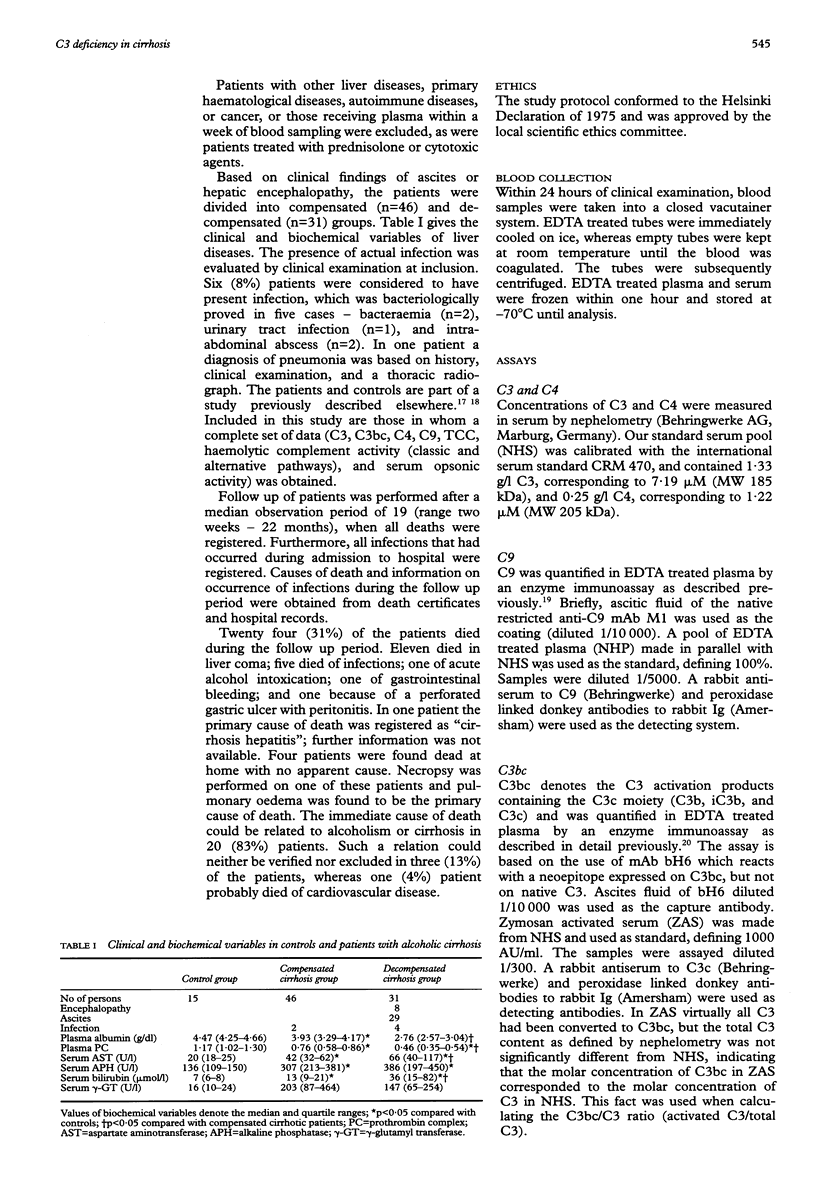
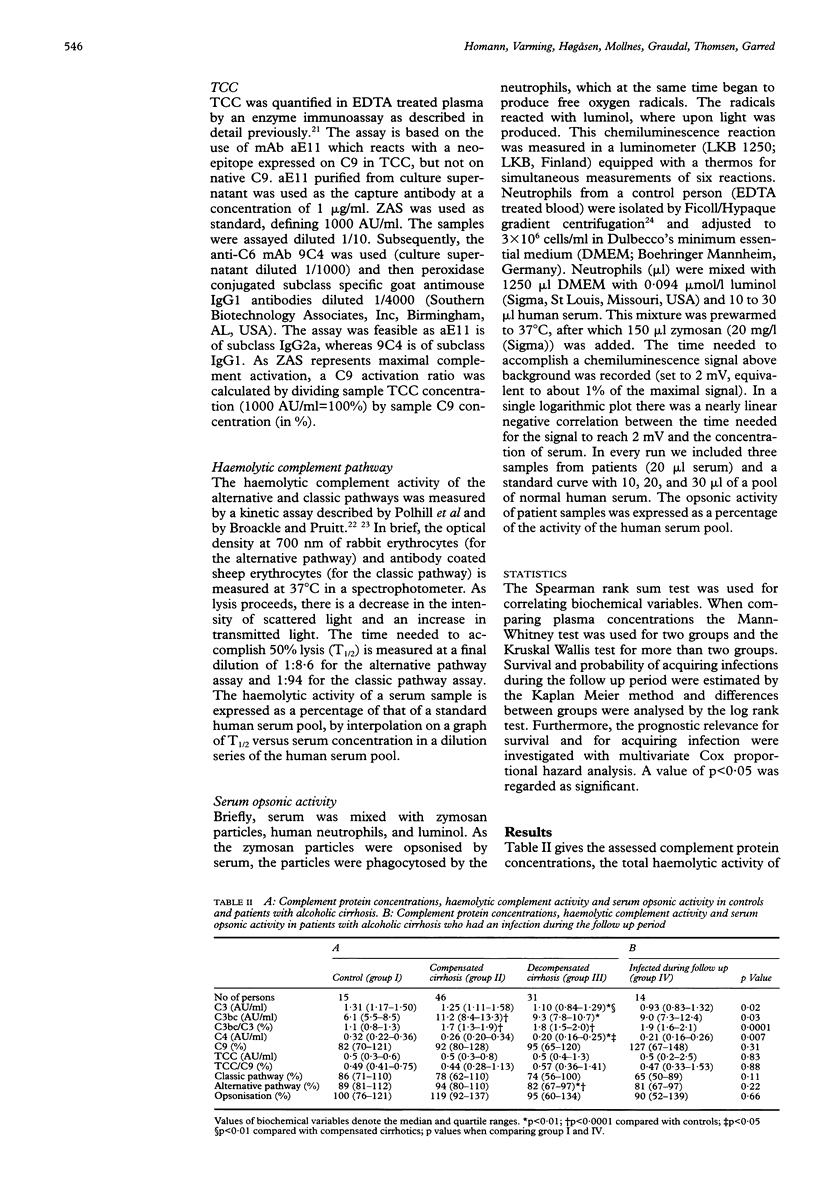
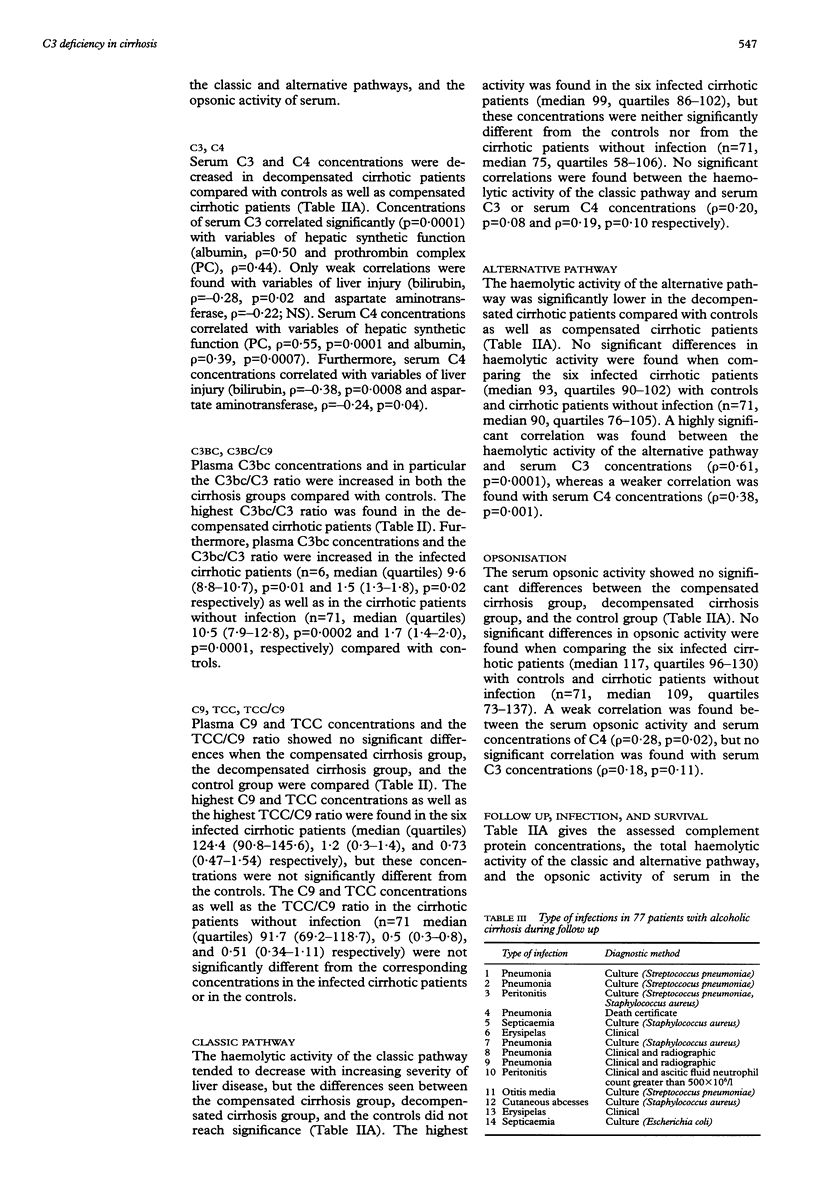
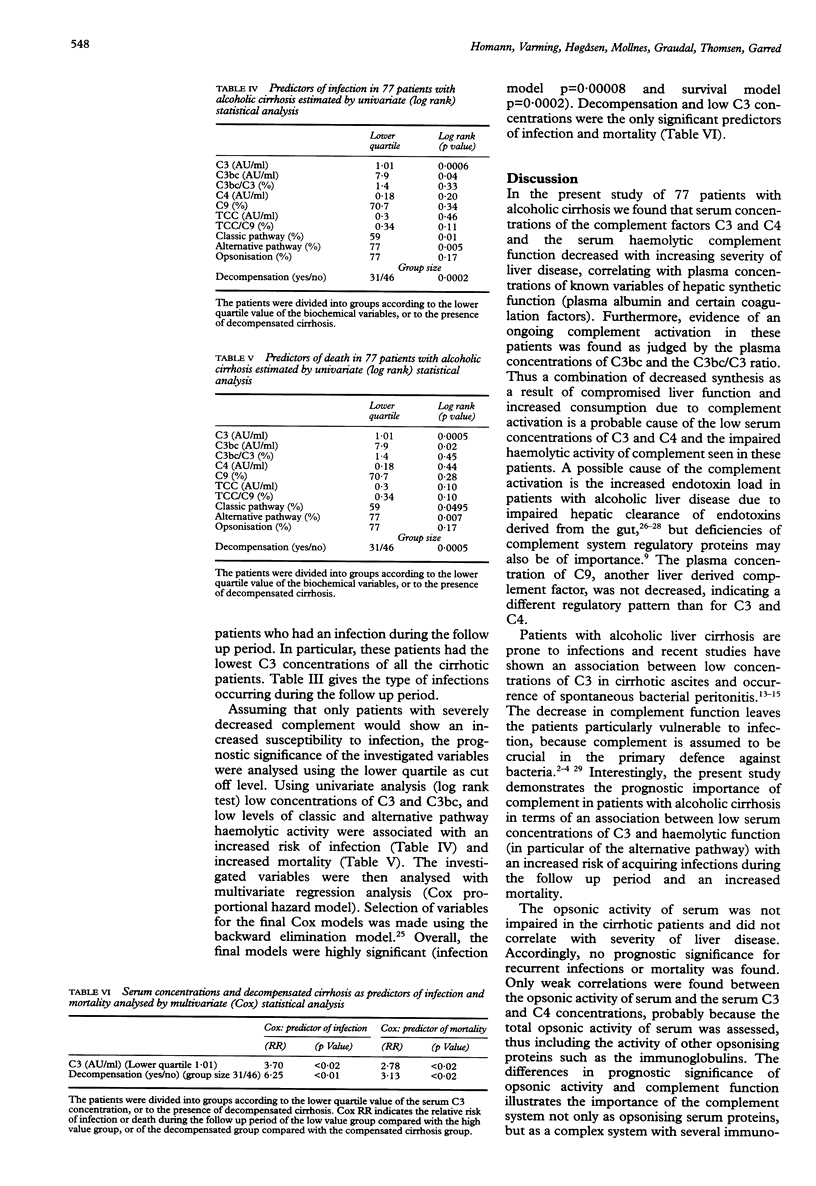
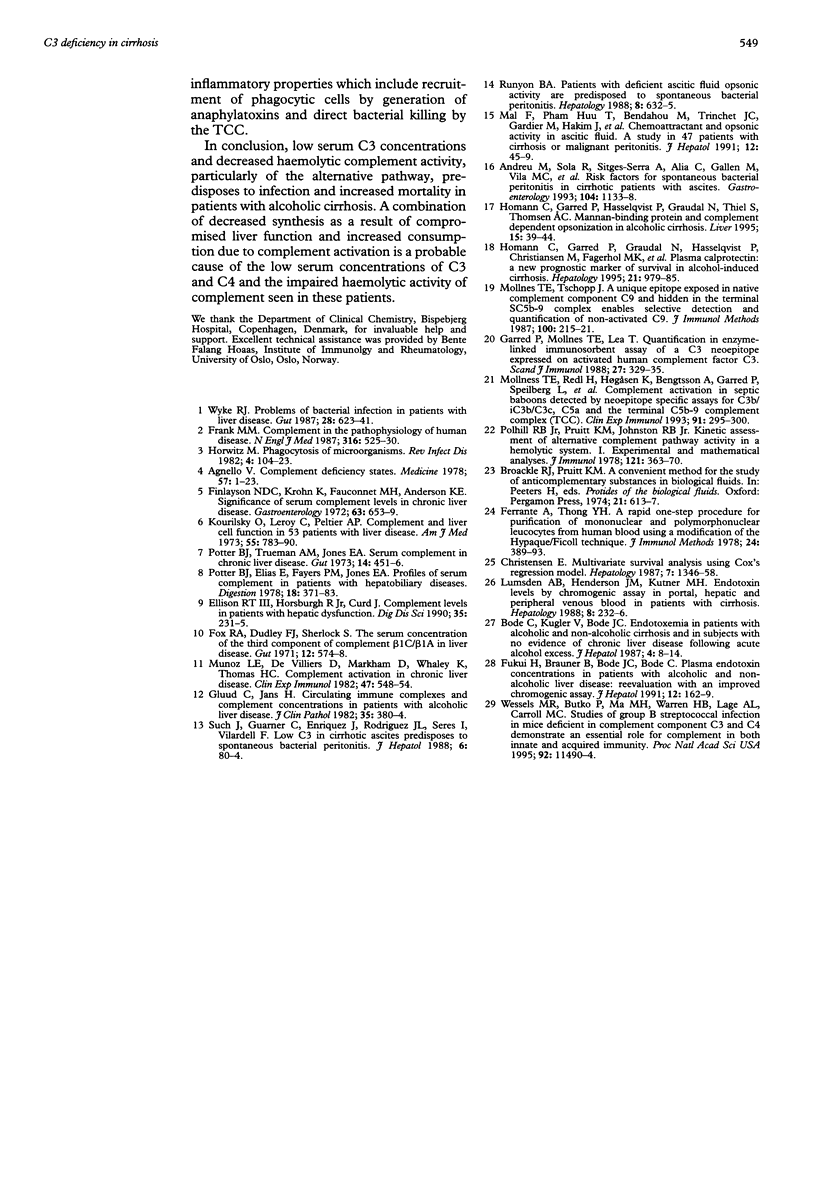
Selected References
These references are in PubMed. This may not be the complete list of references from this article.
- Agnello V. Complement deficiency states. Medicine (Baltimore) 1978 Jan;57(1):1–23. doi: 10.1097/00005792-197801000-00001. [DOI] [PubMed] [Google Scholar]
- Andreu M., Sola R., Sitges-Serra A., Alia C., Gallen M., Vila M. C., Coll S., Oliver M. I. Risk factors for spontaneous bacterial peritonitis in cirrhotic patients with ascites. Gastroenterology. 1993 Apr;104(4):1133–1138. doi: 10.1016/0016-5085(93)90284-j. [DOI] [PubMed] [Google Scholar]
- Bode C., Kugler V., Bode J. C. Endotoxemia in patients with alcoholic and non-alcoholic cirrhosis and in subjects with no evidence of chronic liver disease following acute alcohol excess. J Hepatol. 1987 Feb;4(1):8–14. doi: 10.1016/s0168-8278(87)80003-x. [DOI] [PubMed] [Google Scholar]
- Christensen E. Multivariate survival analysis using Cox's regression model. Hepatology. 1987 Nov-Dec;7(6):1346–1358. doi: 10.1002/hep.1840070628. [DOI] [PubMed] [Google Scholar]
- Ellison R. T., 3rd, Horsburgh C. R., Jr, Curd J. Complement levels in patients with hepatic dysfunction. Dig Dis Sci. 1990 Feb;35(2):231–235. doi: 10.1007/BF01536768. [DOI] [PubMed] [Google Scholar]
- Ferrante A., Thong Y. H. A rapid one-step procedure for purification of mononuclear and polymorphonuclear leukocytes from human blood using a modification of the Hypaque-Ficoll technique. J Immunol Methods. 1978;24(3-4):389–393. doi: 10.1016/0022-1759(78)90143-6. [DOI] [PubMed] [Google Scholar]
- Finlayson N. D., Krohn K., Fauconnet M. H., Anderson K. E. Significance of serum complement levels in chronic liver disease. Gastroenterology. 1972 Oct;63(4):653–659. [PubMed] [Google Scholar]
- Fox R. A., Dudley F. J., Sherlock S. The serum concentration of the third component of complement beta-1C-beta-1A in liver disease. Gut. 1971 Jul;12(7):574–578. doi: 10.1136/gut.12.7.574. [DOI] [PMC free article] [PubMed] [Google Scholar]
- Garred P., Mollnes T. E., Lea T. Quantification in enzyme-linked immunosorbent assay of a C3 neoepitope expressed on activated human complement factor C3. Scand J Immunol. 1988 Mar;27(3):329–335. doi: 10.1111/j.1365-3083.1988.tb02354.x. [DOI] [PubMed] [Google Scholar]
- Gluud C., Jans H. Circulating immune complexes and complement concentrations in patients with alcoholic liver disease. J Clin Pathol. 1982 Apr;35(4):380–384. doi: 10.1136/jcp.35.4.380. [DOI] [PMC free article] [PubMed] [Google Scholar]
- Homann C., Garred P., Graudal N., Hasselqvist P., Christiansen M., Fagerhol M. K., Thomsen A. C. Plasma calprotectin: a new prognostic marker of survival in alcohol-induced cirrhosis. Hepatology. 1995 Apr;21(4):979–985. [PubMed] [Google Scholar]
- Homann C., Garred P., Hasselqvist P., Graudal N., Thiel S., Thomsen A. C. Mannan-binding protein and complement dependent opsonization in alcoholic cirrhosis. Liver. 1995 Feb;15(1):39–44. doi: 10.1111/j.1600-0676.1995.tb00105.x. [DOI] [PubMed] [Google Scholar]
- Horwitz M. A. Phagocytosis of microorganisms. Rev Infect Dis. 1982 Jan-Feb;4(1):104–123. doi: 10.1093/clinids/4.1.104. [DOI] [PubMed] [Google Scholar]
- Kourilsky O., Leroy C., Peltier A. P. Complement and liver cell function in 53 patients with liver disease. Am J Med. 1973 Dec;55(6):783–790. doi: 10.1016/0002-9343(73)90259-3. [DOI] [PubMed] [Google Scholar]
- Lumsden A. B., Henderson J. M., Kutner M. H. Endotoxin levels measured by a chromogenic assay in portal, hepatic and peripheral venous blood in patients with cirrhosis. Hepatology. 1988 Mar-Apr;8(2):232–236. doi: 10.1002/hep.1840080207. [DOI] [PubMed] [Google Scholar]
- Mal F., Huu T. P., Bendahou M., Trinchet J. C., Garnier M., Hakim J., Beaugrand M. Chemoattractant and opsonic activity in ascitic fluid. A study in 47 patients with cirrhosis or malignant peritonitis. J Hepatol. 1991 Jan;12(1):45–49. doi: 10.1016/0168-8278(91)90907-s. [DOI] [PubMed] [Google Scholar]
- Mollnes T. E., Redl H., Høgåsen K., Bengtsson A., Garred P., Speilberg L., Lea T., Oppermann M., Götze O., Schlag G. Complement activation in septic baboons detected by neoepitope-specific assays for C3b/iC3b/C3c, C5a and the terminal C5b-9 complement complex (TCC). Clin Exp Immunol. 1993 Feb;91(2):295–300. doi: 10.1111/j.1365-2249.1993.tb05898.x. [DOI] [PMC free article] [PubMed] [Google Scholar]
- Mollnes T. E., Tschopp J. A unique epitope exposed in native complement component C9 and hidden in the terminal SC5b-9 complex enables selective detection and quantification of non-activated C9. J Immunol Methods. 1987 Jun 26;100(1-2):215–221. doi: 10.1016/0022-1759(87)90192-x. [DOI] [PubMed] [Google Scholar]
- Munoz L. E., De Villiers D., Markham D., Whaley K., Thomas H. C. Complement activation in chronic liver disease. Clin Exp Immunol. 1982 Mar;47(3):548–554. [PMC free article] [PubMed] [Google Scholar]
- Polhill R. B., Jr, Pruitt K. M., Johnston R. B., Jr Kinetic assessment of alternative complement pathway activity in a hemolytic system. I. Experimental and mathematical analyses. J Immunol. 1978 Jul;121(1):363–370. [PubMed] [Google Scholar]
- Potter B. J., Elias E., Fayers P. M., Jones E. A. Profiles of serum complement in patients with hepatobiliary diseases. Digestion. 1978;18(5-6):371–383. doi: 10.1159/000198223. [DOI] [PubMed] [Google Scholar]
- Potter B. J., Trueman A. M., Jones E. A. Serum complement in chronic liver disease. Gut. 1973 Jun;14(6):451–456. doi: 10.1136/gut.14.6.451. [DOI] [PMC free article] [PubMed] [Google Scholar]
- Runyon B. A. Patients with deficient ascitic fluid opsonic activity are predisposed to spontaneous bacterial peritonitis. Hepatology. 1988 May-Jun;8(3):632–635. doi: 10.1002/hep.1840080332. [DOI] [PubMed] [Google Scholar]
- Such J., Guarner C., Enriquez J., Rodriguez J. L., Seres I., Vilardell F. Low C3 in cirrhotic ascites predisposes to spontaneous bacterial peritonitis. J Hepatol. 1988 Feb;6(1):80–84. doi: 10.1016/s0168-8278(88)80465-3. [DOI] [PubMed] [Google Scholar]
- Wessels M. R., Butko P., Ma M., Warren H. B., Lage A. L., Carroll M. C. Studies of group B streptococcal infection in mice deficient in complement component C3 or C4 demonstrate an essential role for complement in both innate and acquired immunity. Proc Natl Acad Sci U S A. 1995 Dec 5;92(25):11490–11494. doi: 10.1073/pnas.92.25.11490. [DOI] [PMC free article] [PubMed] [Google Scholar]
- Wyke R. J. Problems of bacterial infection in patients with liver disease. Gut. 1987 May;28(5):623–641. doi: 10.1136/gut.28.5.623. [DOI] [PMC free article] [PubMed] [Google Scholar]


